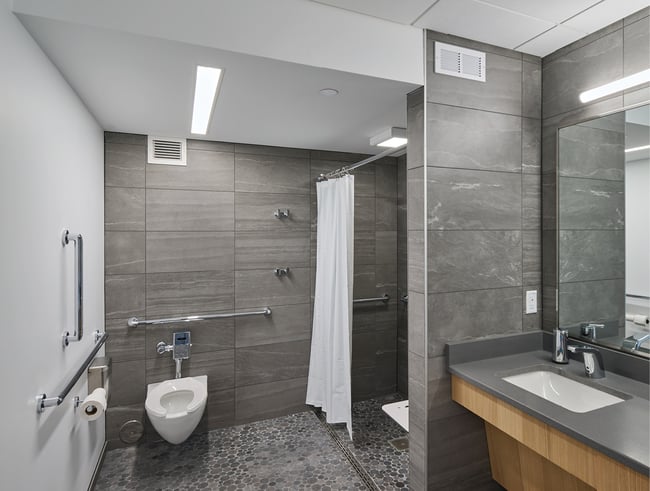Inclusion and Access: LBC Equity Petal at the Stanley Center

The Living Building Challenge (LBC) is an opportunity to bring together diverse stakeholders and transform communities. Its Equity Petal seeks to foster a more just and inclusive world that enables all people to participate, prosper, and reach their potential. By setting accessible design and project team inclusion requirements, it offers a pathway for making this vision a reality.
In Muscatine, Iowa, the Stanley Center for Peace and Security is on its way to becoming the second renovation project to achieve a full Living Building Certification. To celebrate this achievement, we are discussing how the project fulfills each component of the LBC framework.
This article will discuss the Equity Petal and how the Stanley Center aligns with its goals.
Understanding the Equity Petal
Overseen by Living Future, the LBC is the most rigorous and holistic building certification program. Its framework is divided into seven categories known as Petals, which include:
- Place
- Water
- Energy
- Health and Happiness
- Materials
- Equity
- Beauty
The Equity Petal focuses on participation in the design and construction process and access to the completed building. A Living Building should have a positive impact on the community by creating opportunities to include those who have been disadvantaged or excluded historically.
It sees equity as a prerequisite for sustainability. A community that allows for inclusion and equal access is better equipped to restore and protect the natural environment.
The Equity Petal at the Stanley Center
Each LBC Petal is broken into separate requirements called imperatives. The Equity Petal includes two: Universal Access and Inclusion. Below, we’ll discuss these imperatives in greater detail and how they were interpreted at the Stanley Center.
Universal Access
The Universal Access imperative focuses on access within the completed building. It safeguards those with disabilities by requiring projects to adhere to Universal Design principles, as well as the Americans with Disabilities Act (ADA) and the Architectural Barriers Act (ABA) accessibility guidelines.
Universal Design principles ensure a building can be accessed, understood, and used to the greatest extent possible by all people. Rather than provide a separate experience for those with disabilities, Universal Design seeks to create the same experience for all.
At the Stanley Center, counters, appliances, and sinks are ADA-compliant, and thresholds are minimized to promote equal access. Some planting beds are raised to allow everyone to participate in the building’s urban agriculture program.
Similarly, all restrooms are single-use and gender-neutral. Anyone—regardless of identity or ability—has the same restroom experience.

Restrooms are gender-neutral and fully accessible.
For the project team, equity meant that every occupant had the resources and tools to succeed. Instead of providing everyone with the same experience, they worked to ensure everyone could reach equal outcomes.
Office furniture came in a kit-of-parts, allowing everyone to select the necessary components for their roles. While some people took file cabinets, others took bookshelves.
The same logic applied to guest furniture. The facility contains a mix of lounge chairs, sofas, ottomans, and high-top tables, allowing everyone to select the seating that best suits their personal comfort.

Offices without a direct view received a skylight and green wall.
Likewise, the team worked to provide equitable daylight access throughout the facility. While some offices have a window and a view of the outdoors, others have a skylight and green wall. Occupants without a direct view can still benefit from daylight and biophilia.
Inclusion
The Inclusion Imperative seeks to support diverse businesses and create stable, safe, and high-paying job opportunities for people in the local community.
It sets requirements for participation in the JUST program, a “nutrition label” overseen by Living Future that assesses organizations and their operations.
The program helps organizations evaluate their practices and notice blind spots. It can help uncover problems with gender pay equity or employee engagement that may have gone unnoticed otherwise. As a transparency platform, JUST benefits employees, helping them understand operational practices and how the organization compares to others.
To fulfill the Inclusion Imperative, at least two project team members must receive a Just Label. The Stanley Center project surpassed these expectations with five project teams participating in the program: the Stanley Center, Neumann Monson, Graham Construction, Biohabitats, and Integrated Eco Strategies. An additional 21 team members completed Just self-assessments, surpassing the required five.
The Inclusion Imperative also sets requirements for contracts with Minority, Women, or Disadvantaged Business Enterprises (MWDBE). Whenever possible, the team worked to give preference to these businesses for trade work.
Options were not always available, so the project team opted to donate to an organization that supports these businesses and helps make them more competitive.
Moving Beyond the Equity Petal
Throughout the design process, the Stanley Center worked to increase inclusion and equity. Design meetings and workshops involved a cross-section of the Stanley Center staff. From site selection workshops to Design Development discussions, occupants could weigh in and share their opinions.
Early in the process, the Stanley Center surveyed the Muscatine community to determine how the project could align with their needs. Later discussions involved input from local artists and staff at the Musser Public Library.
The design process occurred during the Covid-19 pandemic. While remote work presented challenges, it created a more equitable experience for everyone. Everyone could participate in design discussions equally and share opinions over video calls.
Learn More About the Living Building Challenge
The LBC’s requirements extend beyond traditional sustainable design goals. While focusing on energy and water consumption, it also emphasizes inclusion and equity—asserting that equal access is a prerequisite for a more sustainable world.
At the Stanley Center, Universal Design principles help ensure everyone can access the facility and have a similar experience. Just Labels have an impact on the local community, helping project participants evaluate their operations and improve internal equity.
Since the project’s completion, the Stanley Center continues to support equity and inclusion. As a former public library, the building attracts attention from curious passersby. The Stanley Center engaged the community through a Sustainability Fair and continues to educate the public on the building’s sustainable systems through tours.
Education and community engagement are key parts of the LBC, and owners should be prepared for a more inclusive process. To learn if this certification system fits your goals, read about the questions to ask before taking on the LBC.